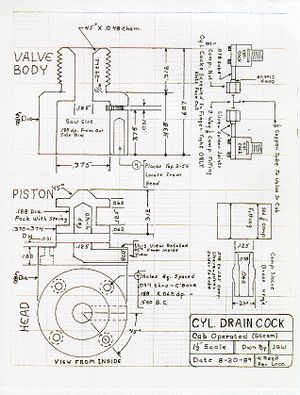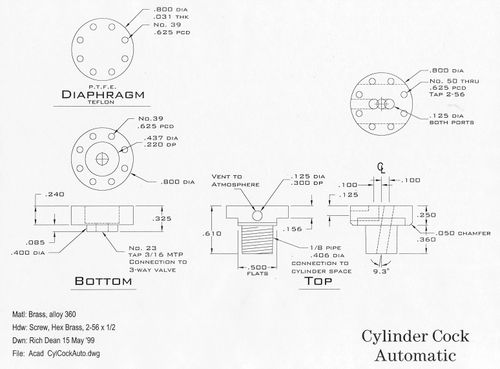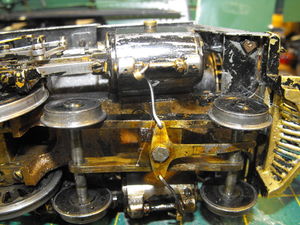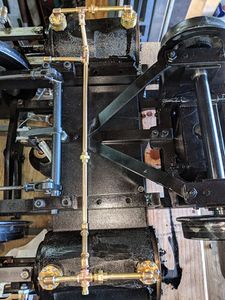Cylinder cocks
Manual
See Cab Operated Cylinder Cocks
Joe Whitaker

Automatic

See also "Steam Operated Drain Cocks by Peter Squire"
Small Cylinder Cocks
by R. G. Neff
The Live Steamer, Jan-Feb 1950
Cylinder cocks are a necessity on any steam engine, large or small, and for a small model such as an O Gauge locomotive, they are difficult to make at anywhere near scale size. However, I feel that in some places successful operation is much more important than appearance and my cylinder cocks, although rather clumsy looking, are easy to make and effective in operation and in their position down under the cylinders don't show too plainly anyway.
To make these cocks, have a rib on your cylinder casting at the bottom of each cylinder parallel to the bore. After facing, etc., drill a hole lengthwise of the rib and ream 1/8 inch. This assures alignment of the holes in both cocks. The metal can now be cut out from between the cocks, leaving 3/16 inch at each end. Now drill 1/32 inch holes as indicated in sketch. The hole marked X doesn't do anything, but you have to go through it to drill to the cylinders.
In drilling cast iron, a small drill is liable to catch and snap off as it breaks through the underside. To prevent this put a piece of 1/8 inch brass rod in the 1/8 holes and make a brass plug to fit into the ends of the cylinder bores so there is metal in contact with the under side to drill into. As from full size to 0.001 inch or more under select a piece that turns freely but not sloppy in the reamed holes. Notch half through with a saw or knife file as indicated in the sketch, spaced exactly the same as the drain holes. Drill and tap for the plug and lever, which will keep the rod in its proper place. Obviously, when the lever is a t 45 degrees, pointing toward the rail, the cock is closed, and when pointing outward at the same angle, it is open through the side holes. A simple T lever underneath opens and closes both sides. These cocks may leak very slightly, but whoever saw a locomotive on the railroad that didn't show a little steam escaping at various places? If you bevel or round off the corners of the cocks they will look a lot smaller.
Roll Neff O Gauge Hudson with working Cylinder Cocks. From O Gauge Railroading
Steam Operated
Example of pipework for steam-operated cylinder cocks by Chris Brew.
See also
External Links
- "Cylinder cocks", Chaski.org
- "Cylinder cock design from latest live steam mag", Chaski.org
- "Discussion about cylinder drain cocks", Chaski.org
- Okadee Cylinder Drains, Chaski.org
- "Allen Mogul Cylinder Drains and Linkage"
- "yet another cylinder cock design (steam actuated)", Chaski.org
- "Cylinder Cock Setup", Chaski.org
- "Cylinder Drain Design", Chaski.org
- "Inspiration", Van Brocklin drains for LE American, Chaski.org
- "Steam-operated cylinder drains", Chaski.org


